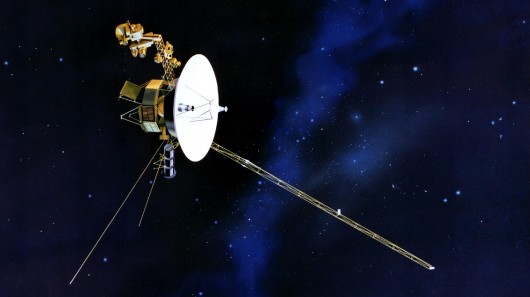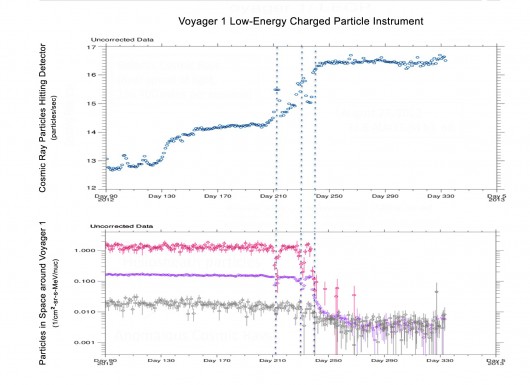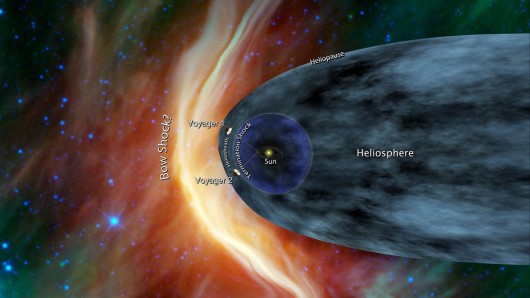Voyager 1 leaves the Solar System?
By David Szondy
March 20, 2013

Artist's impression of Voyager 1 (Image: NASA)
Has Voyager 1 left the Solar System? Is it officially the first spacecraft to reach interstellar space? It depends on whom you ask. NASA says no, but W.R. Webber of the New Mexico State University Department of Astronomy and F.B. McDonald of the University of Maryland Institute of Physical Science and Technology say yes. They contend that the unmanned, nuclear-powered probe left the Solar System on August 25, 2012 at a distance of 121.7 AU (18.2 billion km) from the Sun when its instruments on board detected a major shift in cosmic ray intensity.
Voyager 1 is one of the two Voyager deep space probes sent by NASA to study the outer planets and the frontiers of the Solar System. The 722 kilogram (1,590 lb) spacecraft was launched 35 years ago on September 5, 1977 and is powered by three radiothermal generators. In 1979, it flew by Jupiter and in 1980 it visited Saturn. As it did so, the giant planets sent Voyager on a one-way slingshot trajectory toward interstellar space at a speed of 17.043 km/s (38,120 mph) relative to the Sun.
At its current distance, Voyager 1 is so far away that it takes radio signals almost 17 hours to reach Earth. This puts the probe a long way from any real estate, but according to scientists the Solar System extends even to that tremendous distance. For astronomers, the Solar Systemís boundary is the point where the Sun is no longer able to push out the incredibly tenuous bubble of gas that surrounds it called the heliosphere and where its magnetic sphere no longer dominates. It is this boundary that Weber and McDonald claim that Voyager has passed.
According to them, Voyager 1 experienced a dramatic shift in radiation on August 25, 2012. Previously, the radiation detected was dominated by what are called Anomalous Cosmic Rays (ACR), which are cosmic ray particles that have become trapped by the Sunís magnetic field. However, on that day, the intensity of the ACRs dropped to less than one percent within hours and over the next few days decreased by a factor of up to 500. Meanwhile, the intensity of Galactic Cosmic Rays (GCR), which are cosmic rays from outside the Solar System, doubled.
"Within just a few days, the heliospheric intensity of trapped radiation decreased, and the cosmic ray intensity went up as you would expect if it exited the heliosphere," said Webber.
However, NASA disagrees with the findings, saying in a statement: "The Voyager team is aware of reports today that NASA's Voyager 1 has left the solar system," said Edward Stone, Voyager project scientist based at the California Institute of Technology, Pasadena, California. "It is the consensus of the Voyager science team that Voyager 1 has not yet left the solar system or reached interstellar space. In December 2012, the Voyager science team reported that Voyager 1 is within a new region called 'the magnetic highway' where energetic particles changed dramatically. A change in the direction of the magnetic field is the last critical indicator of reaching interstellar space and that change of direction has not yet been observed."
Voyager 1 is currently the most distant man-made object to leave Earth and NASA says that the probe will have enough power to transmit signals until 2025. After that, itís next port of call will be the star AC+79 3888, 17.6 light years away in the constellation of Camelopardalis, which Voyager 1 will pass within 1.6 light years of in 40,000 years.
Weber and McDonaldís findings will be published in the journal Geophysical Research Letters.
The video below outlines the Voyager missions.
Sources: American Geophysical Union, NASA
Copyright © gizmag 2003 - 2013 To subscribe or visit go to: http://www.gizmag.com
http://www.gizmag.com/voyager-1-heliosphere-interstellar-space/26736/?utm_source=Gizmag+Subscribers&utm_campaign=3fb765dddb-UA-2235360-4&utm_medium=email

